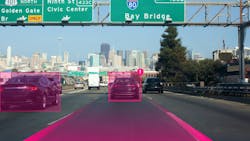One machine learning application is transforming how cameras can reinforce fleet safety: computer vision.
“Even though billions of dollars have been poured into AI investments generally, computer vision is arguably the only segment that was providing real, tangible, measurable impacts in ROI,” Nihar Gupta, product leader for Motive, told FleetOwner.
Computer vision applications offer fleets transformative upgrades to safety and productivity. Beyond automated truck/trailer detection at warehouses, cold storage inventory monitoring, and self-driving trucks, these applications also reduce unsafe driving through a truck’s inward- and outward-facing cameras.
See also: Trucking's AI outlook: What solutions await in 2025
“That is our North Star: reducing collisions, making the road safer, saving lives,” Gupta said. “Then, ultimately, it also helps fleets make it more profitable.”
Motive embraced computer vision with its inward- and outward-facing cameras, which use AI models built directly into the devices.
Unsafe driving detection
The smart devices monitor several types of unsafe driving inside and outside the cab. When they detect an unsafe event, they can immediately notify the driver.
The outward-facing cameras can detect unsafe driving events ranging from rolling stops to dodgy lane changes and beyond. The inward-facing cameras can detect drowsiness, distraction, seatbelt violations, and smoking. Motive said it can capture these events with high accuracy, detecting 88-99.5% of events with 0.5-12% false positives.
Computer vision on the edge
Motive’s computer vision occurs in the camera housing itself. Computing on the edge is important for safety-critical operations. When collisions are at risk, milliseconds are essential.
“If they’re [the driver] about to collide with the vehicle, we need to give them that real-time feedback,” Gupta said.
The company uses a custom AI model on an Ambarella processor in the camera housing to ensure rapid responses.
AI chips in the camera enable quick assessment of objects, vehicles, driver attention, and more. The video data also feeds into a remote server for the fleet’s later coaching and review.
The camera and AI computer are optimized for the truck’s edge environment. Both inward and outward cameras are engineered to operate across wide temperature ranges. The company’s external Omnicams are IP69K-rated to withstand significant water pressure, dust, and temperature conditions.
Gupta said fleets have the option to keep recording even when the engine is off for 24 hours with no ill impact to the battery.
“You’re able to get a massive volume of data input from these cameras, use that with computer vision, and determine a lot about how risky or safe your fleet is,” Gupta said.
When the cameras detect unsafe driving, they can notify both the driver and office personnel. Fleets can use these safety insights to coach their drivers or to generate automated coaching messages.
One example is Motive's work with FusionSite Services, a waste management provider running 800 units—mostly light-duty vehicles. The fleet used a combination of dual-facing cameras, in-cab alerts, and automated in-cab coaching to mitigate drivers’ unsafe practices.
See also: SureCam secures $36M for AI fleet safety technology
“We helped them reduce accidents by 89% and reduce unsafe behaviors by 92%,” Gupta said.
Accuracy is key
For safety-critical operations, AI tools need to work as reliably as possible.
“Accuracy really does matter,” Gupta emphasized. “It’s the difference between life and death.”
Missing unsafe driving events can be catastrophic, and even false positives can deteriorate staff trust in the system. To mitigate this, Motive constantly improves the accuracy of its computer vision models.
The company trains its models with tens of thousands of videos and images to help detect distracted driving, drowsiness, collisions, and more.
The Motive R&D team continually learns about edge cases, gathers customer feedback, and builds that information into the model for greater precision. Every week, the company releases new updates to its models.
“We obsessively test them and improve them,” Gupta said. “That’s what gets us to that 99% accuracy.”
The company also pursues third-party benchmarking to remain competitive. Studies funded by Motive, from Virginia Tech Transportation Institute and Strategy Analytics, claimed that the company’s dashcams generated unsafe driving alerts more quickly and accurately than its main competitors, Samsara and Lytx.
Training with generative AI
Motive also uses generative AI to complement real-world data when training its models, what Gupta calls “synthetic data.” The company uses video generation models like Sora to develop the synthetic data. This helps make model training a much faster process.
“The synthetic data allows us to get after edge cases strongly, which you might not be able to find great videos for,” Gupta said. “With generative AI, you can create those scenes and use that to augment a lot of the data you have.”
For example, Motive used generative AI to develop training data to pursue drowsiness edge-cases—varying light levels, camera angles, and driver positions—to complement its foundational real-world training data.
AI in 2025
As AI continues to reshape the transportation industry, how will the market change this year? Gupta told FleetOwner that the development of models will likely continue to become more rapid.
“The development of AI models and the cycle time to make them is shrinking tremendously,” Gupta said. “Whereas it might take a few months to build a model historically, that time is shrinking where you can do that in weeks.”
In trucking, Gupta expects more fleets to pursue accurate, automated coaching to bring quick feedback to drivers.
“One area where I think we’re starting to see a lot of demand for this is from a coaching standpoint. Coaching is a very time-intensive and resource-intensive exercise,” Gupta said. “Fleets oftentimes don’t have a ton of personnel or bandwidth to do what’s required and do it in a timely way. This is where AI can really help.”
About the Author
Jeremy Wolfe
Editor
Editor Jeremy Wolfe joined the FleetOwner team in February 2024. He graduated from the University of Wisconsin-Stevens Point with majors in English and Philosophy. He previously served as Editor for Endeavor Business Media's Water Group publications.




